Google’s Antitrust Play Should be a Massive Pivot…
Earlier this week, the U.S. Department of Justice, along with Attorneys General from 11 states, filed a long-expected antitrust lawsuit accusing Google of being a monopoly gatekeeper for the Internet. The suit draws on section 2 of the Sherman Antitrust Act, which makes it illegal to monopolize trade or commerce. Of course Google will fight the lawsuit but in our view, the company must make bigger moves to diversify its business and the answer we feel is in the cloud and edge.
In this Breaking Analysis we will to two things: 1) we’ll review the history (according to Dave Vellante) of monopolistic power in the computer industry; and 2) we’ll look into the latest ETR data and make the case that Google’s response to the DoJ’s suit should be to double or triple its focus on cloud and edge computing – a multi-trillion dollar opportunity.
Brief History of Monopolies in Tech
IBM
In 1969, the U.S. government filed an antitrust lawsuit against IBM. At the height of its power, IBM generated about 50% of the revenue and 2/3rds of the profits for the entire computer industry. IBM’s monopoly, on a relative basis, far exceeded that of the virtual Wintel monopoly that defined the 1990’s.
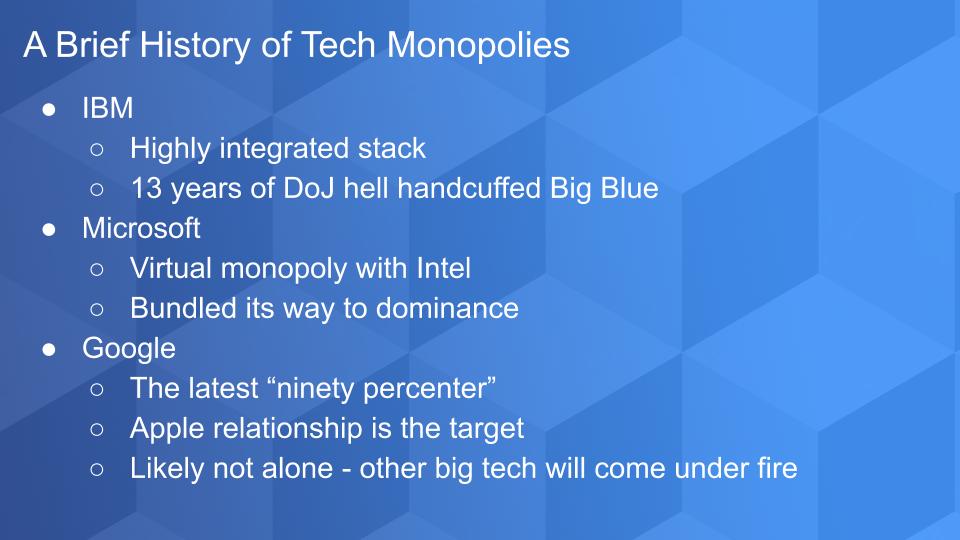
IBM had 90% of the mainframe market and controlled the protocols to a highly vertically integrated mainframe stack comprising semiconductors, operating systems, tools and compatible peripherals, like terminals, storage and printers. The government’s lawsuit dragged on for 13 years before it was withdrawn in 1982, but it took a toll on IBM. To placate the government, IBM made concessions such as allowing mainframe plug compatible competitors access to its code and limiting the bundling of application software in fear of more government pressure.
The biggest mistake IBM made coming out of antitrust was holding onto its mainframe past. We saw this in the way it tried to recover from the mistake of handing its monopoly over to Microsoft and Intel by keeping OS/2 and giving Microsoft Windows, thinking that the PC could be vertically integrated like the mainframe.
Microsoft
Microsoft’s monopoly power was earned in the 1980’s and carried into the 1990’s. In 1998, the DoJ filed a lawsuit against Microsoft alleging that the company was illegally thwarting competition, which I argued at the time it was. Ironically, this is the same year that Google was started – we’ll come back to that in a minute.
In the early days of the PC, Microsoft was not a dominant player in desktop software. Lotus 123, Wordperfect and Harvard Presentation Graphics were discreet products that competed effectively in the market. In 1987, Microsoft paid $14M for PowerPoint and then in 1990 launched Office, which bundled spreadsheets, word processing and presentation into a single suite, priced far more attractively than alternative point products.
In 1995, Microsoft launched Internet Explorer and began bundling its browser into Windows for free. Windows had a 90% market share. Netscape was the browser leader and a high flying tech company. The company’s management at the time poo poo’d Microsoft’s bundling, saying they weren’t concerned because they were moving up the stack into business software. They later changed that position after realizing the damage Microsoft bundling would do to its business but it was too late.
In similar moves of ineptness, Lotus refused to support Windows at its launch and instead wrote software to support the DEC VAX – a minicomputer that you probably never heard of. Novell, a leader in networking software at the time – (anyone remember Netware?) – responded to Microsoft’s moves to bundle network services into its OSes by going on a disastrous buying spree, acquiring Wordperfect, QuattroPro (a spreadsheet) and a Unix OS.
The difference between Microsoft and IBM is that Microsoft didn’t build hardware, rather it partnered with Intel to create a virtual monopoly. The similarities between IBM and Microsoft however were that it fought the DoJ hard and made similar mistakes to IBM by handing on to its PC software legacy…until the company finally pivoted to the cloud under the leadership of Satya Nadella. But one could argue that the DoJ distraction led to Google’s ascendency because it contributed to Microsoft completely missing search.
Which Bring us to Google
Google has 90% of the Internet search market. There’s that magic 90 number again. IBM couldn’t argue that consumers weren’t hurt by its tactics– they were – IBM was gouging mainframe customers because it could. Microsoft on the other hand could argue that consumers were benefiting from lower prices because Microsoft bombed the market.
Google’s attorneys are doing what often happens in these cases. First they’re arguing that the government’s case is “deeply flawed.” Second, they’re saying the government’s actions will cause higher prices because they’ll have to raise prices on mobile software and hardware (hmmm sounds like a threat). And of course it’s making the case that many of its services are free.
What’s different from Microsoft is Microsoft was bundling IE, a product which was largely considered inferior when it first came out. But because of the convenience, most users didn’t bother switching. Google on the other hand has a superior search engine and earned its rightful place at the top by having a far better product than Yahoo, Excite, Infoseek and even Alta Vista– who all wanted to build portals versus a clean user experience with some non-intrusive ads on the side. Boy has that changed hasn’t it?
Regardless. What’s similar in this case with Microsoft is the DoJ is arguing that Google and Apple are teaming up with each other to dominate the market and create a monopoly. Estimates are that Google pays Apple between $8B – $11B annually to have its search engine embedded like a tik into Safari and Siri. That’s about 1/3rd of Google’s profits going to Apple. And it’s obviously worth it because according to the government’s lawsuit, Apple originated search accounts for 50% of Google’s search volume. Incredible.
Does the government have a case here? We’re not qualified to give a firm opinion on this but let’s say this: Even in the case of IBM, where the DoJ eventually dropped the lawsuit, if the U.S. government wants to get you – they usually take more than a pound of flesh.
However, the DoJ did not suggest any specific remedies and the Sherman Act is open to wide interpretation, so we’ll see.
What we are suggesting is that Google should not hug too tightly to its search and advertising past. Yes Google gives us amazing free services but it has every incentive to appropriate our data. And there are innovators out there right now trying to develop answers to that problem where the use of blockchain and other technologies can give power back to the users.
So if we’re arguing that Google shouldn’t, like the other great tech monopolies, hang its hat too tightly onto the past, what should Google do?
The Answer is obvious isn’t it? Cloud, Edge and Data
Let us first say that Google understandably promotes G Suite quite heavily as part of its cloud computing story. We get that but it’s time to move on and aggressively push the areas that matter in cloud: Core infrastructure, database, machine intelligence, containers and the edge. Not to say Google isn’t doing this but these are the areas of greatest growth potential. And the ETR data shows it.
But let’s start with one of our favorite graphics which shows the breakdown of survey respondents used to derive Net Score. 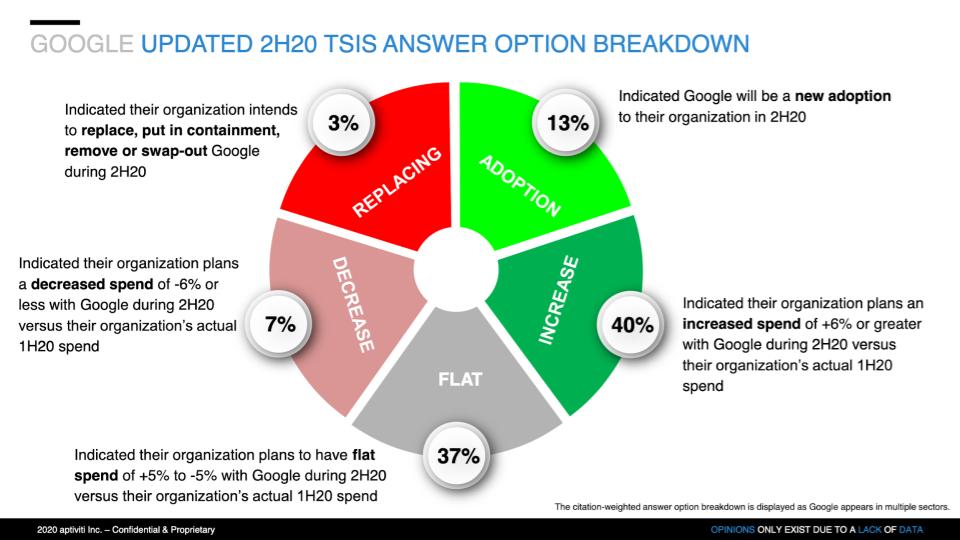
Net Score is ETRs quarterly measurement of spending velocity. Here we show the breakdown for Google Cloud. The lime green is new adoptions, the forest green is the percentage of customers increasing spending more than 5%, the gray is flat, the pinkish is decrease by 6% or more and the bright red is replacing or swapping out the platform. Subtract the reds from the greens and you get a Net Score of 43%, which is not off the charts but it’s good and compares quite favorably with most companies.
But not so favorably with AWS (51%) and Microsoft (49%). Both AWS and Microsoft’s red scores are in the single digits whereas Google’s is at 10%. Look, all three are down since January thanks to COVID but AWS and Microsoft are much larger than Google and we’d like to see stronger across the board scores from Google.
But There’s Good News in Google’s Numbers
Take a look at the chart below. It’s a breakdown of Google’s Net Scores over three surveys snapshots. We skip January in this view to provide year-to-year context for October. Look at the all-important database category. We’ve been watching this closely, particularly with the Snowflake momentum because BigQuery is generally considered the other true cloud native database and we have a lot of respect for what Google is doing in this area.
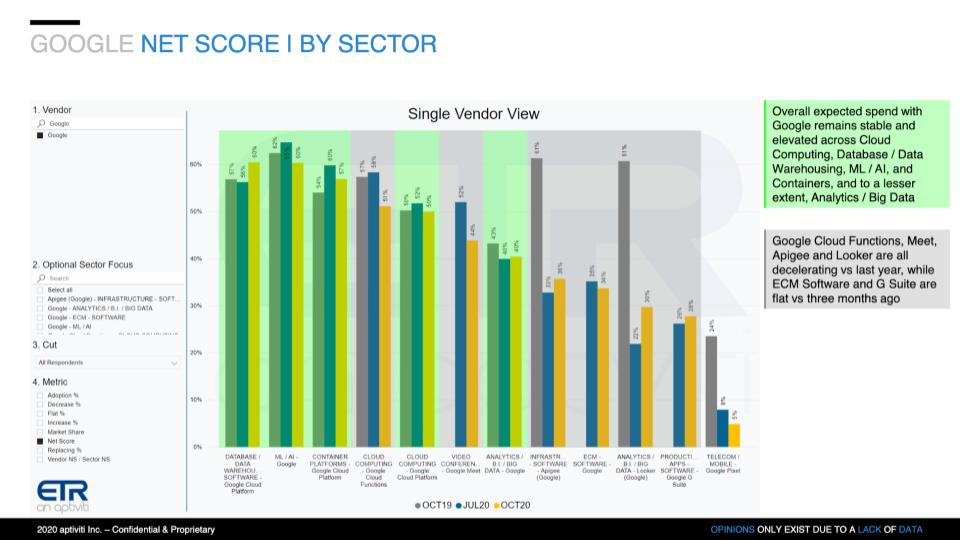
Look at the areas of strength, highlighted in the green. Machine intelligence where Google is an AI leader. Containers…Kubernetes was an open source gift to the industry and a lynchpin of Google’s cloud and multi-cloud strategy. Google cloud is strong overall but we were surprised to see some deceleration in Google Cloud Functions at a 51% Net Score to be honest. Because AWS Lambda and Microsoft Azure Functions are showing in the mid-to-high 60’s for Net Score. But still elevated for Google.
We’re not that worried about steep declines in Apigee and Looker because after an acquisition things kind of get spread around the taxonomy so don’t be too concerned about that. But as we said earlier G Suite – meh – just not that compelling relative to the opportunity in the other areas.
We won’t expose the data here but Google Cloud is showing good strength across almost all industries and sectors with the exception of consulting and small business, which is understandable. But also a notable deceleration in healthcare which is a bit of a concern.
Customer Sentiment on Google
The comments below are from an ETR VENN roundtable.
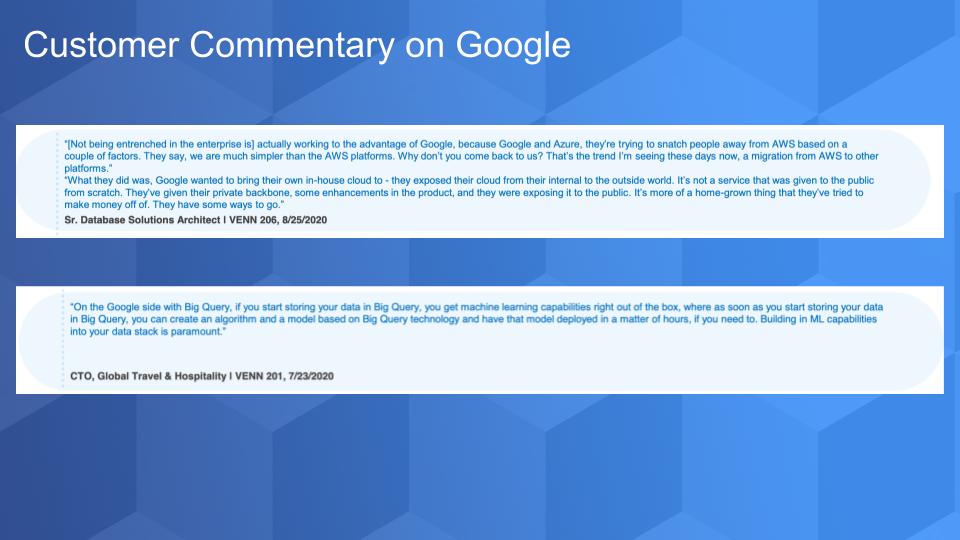
The first comment comes from an architect who says that it’s an advantage that google is not entrenched in the enterprise…not sure we agree but we do take stock in what this person is saying about Microsoft trying to lure people away from AWS. And this person is right that Google essentially exposed its internal cloud to the world and has a ways to go. Which is why we don’t agree with the first sentiment – we feel Google still hasn’t figured out the enterprise.
The second comment underscores a point that we made earlier about BigQuery. Customers really like the out-of-the-box machine learning capabilities. It’s compelling.
Google: Long Road Ahead in Cloud
We’ll update this chart once the companies report earnings but here’s our most recent take on the big 3 cloud vendors’ market performance that we’ve shared before.
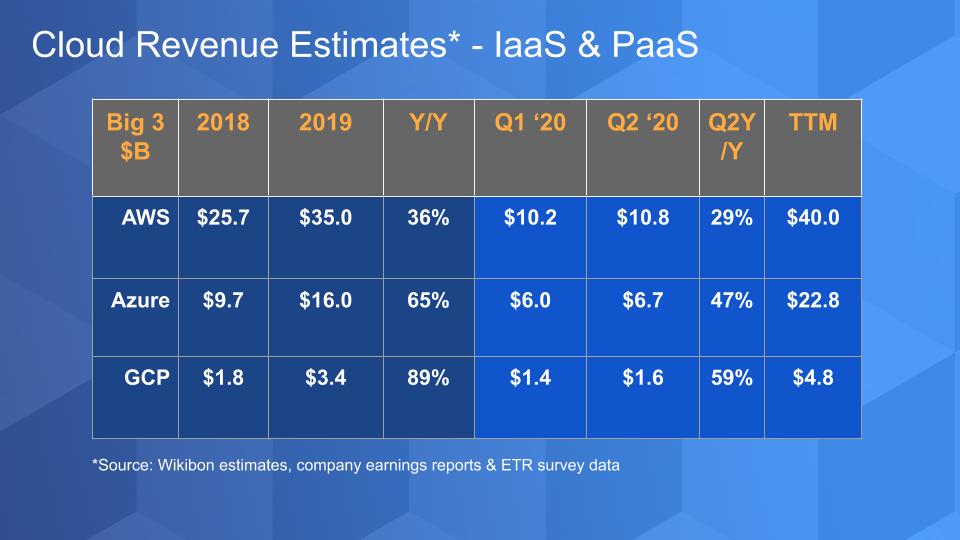
The key points here is our data and the ETR data reflect Google’s comments in its earnings statements that GCP is growing much faster than its overall cloud business which includes things that are not apples-to-apples w/ AWS and Azure. Remember, AWS is the only company that provides clear data on its cloud business whereas the others will make comments but not share the data explicitly so these are estimates based on those comments, survey data and our own intelligence.
And as the one practitioner said – Google has a long ways to go as it is one eighth the size of AWS and about one fifth of the size of Azure. And although it’s growing faster, at this size we feel its growth should be even higher…but COVID is clearly a factor here so we have to take that into consideration.
Google’s Response to Anti-Trust Should be a Massive Pivot
Google spends a lot on R&D. These are quick estimates but we’ll give you some context for the following companies’ R&D spend:
- Google ~$26B at ~16% of revenue
- Apple ~$16B at ~6% of revenue
- Amazon ~$23B at ~8% of revenue
- Microsoft ~$19B at ~13% of revenue
- Facebook ~$14B at ~20% of revenue
So Google for sure spends on innovation. And we’re not including CAPEX in any of these numbers — the hyperscale cloud guys spend tons on CAPEX as you know, building data centers. So we’re not saying Google is “cheaping out” – they’re not.
And they have plenty of cash on their balance sheet at around $120B and so we can’t criticize their roughly $9B in stock buybacks the way we often point fingers at what we consider IBM’s overly Wall Street friendly use of cash. But we’ll say this – it was Jeff Hammerbacher who I spoke with on theCUBE in the early part of last decade at Hadoop World who said “the best minds of my generation are spending their time trying to figure out how to get people to click on ads.” And frankly that’s where much of Google’s R&D budget goes. Again we’re not saying that Google doesn’t spend on cloud computing – it does.
But here’s a prediction. The post cookie apocalypse is coming. Yes Google is banning cookies on Chrome in a couple of years. iOS 14 makes you opt-in to find out everything about you. This is why it’s such a threat to Google. The days when Google was able to be the keeper of all our data and to house it and do whatever it likes with that data ended with GDPR. That was just the beginning of the end. This decade is going to see massive changes in public policy that will directly affect Google and other consumer-facing technology companies.
This decade is going to see massive changes in public policy that will directly affect Google and other consumer-facing technology companies.
So the premise is that Google needs to step up its game in enterprise cloud. Much more than it’s doing today. And we like what Thomas Kurian is doing. But Google is undervalued relative to some of the other big tech names and we think it should tell Wall Street that our future is in enterprise cloud and edge computing and we are going to take a hit to our profitability and go big in those areas. And we would suggest four things:
- Ramp up R&D spending and acquisitions even more. Go on a mission to create a cloud native fabric across all clouds, on-prem and the edge. Yes we know this is your strategy but step it up even more. Forget satisfying investors – you’re getting dinged in the market anyway so now’s is the time to moon Wall Street and attack the opportunity. Unless you don’t see it…but it’s staring you in the face.
- Get way more cozy with the enterprise players that are scared to death of the cloud generally and AWS in particular. Spend the cash and go way way deeper with the big tech players of the past decades…IBM, Dell, HPE, Cisco, Oracle, SAP, etc. Those companies that have the go to market chops to help you win the day in the enterprise. We know you partner with all these companies already. Partner deeper. Identify game changing innovations that you can co-create with these companies and fund it with your cash hoard. We’re essentially saying do what you do with Apple and instead of sucking up all our data and getting us to click on ads, solve really deep problems in the enterprise and edge…which is about actually building an on-prem to cloud to across cloud to edge fabric that really is a unified experience.
- The data collection methods that you’ve used on consumers is incredibly powerful if applied responsibly and correctly for IoT and edge computing. And we don’t mean to trivialize the complexity at the edge. There is no one edge. It’s telcos and factories and banks and cars and we know you’re in all these places because of Android – but there’s a new wave of data coming from machines and autos. There is little doubt that Tesla wants to own its data and Google needs to put forth a strategy that’s win/win. And so far Google, you haven’t done that because your head is in advertising. Get your head out of your ads and cut partners into the feast.
- Double down on your open source commitment. Kubernetes shows the power you have in the industry. Ecosystems are going to be the lynchpin of innovation over the next decade and transcend products and platforms. Use your money, technology and position in the marketplace to create the next generation of technology leveraging the power of the ecosystem.
We expect Google will say “we agree, that’s exactly what we’re doing.” We’re skeptical. We think Google sees the cloud as a little tiny piece of its business. In our view, Google must do what Satya Nadella did and completely pivot to the new opportunity. Make cloud and the edge your mission. Bite the bullet with Wall Street and go dominate a multi-trillion dollar industry.
Remember these episodes are all available as podcasts – please subscribe. We publish weekly on Wikibon.com and Siliconangle.com so check that out and please do comment on the LinkedIn posts we publish. Don’t forget to check out ETR for all the survey data. Get in touch on twitter @dvellante or email david.vellante@siliconangle.com. And remember, Breaking Analysis posts, videos and podcasts are all available at the top link on the Wikibon.com home page.
Thanks everyone, be well and we will see you next time.
Watch the full video analysis:


